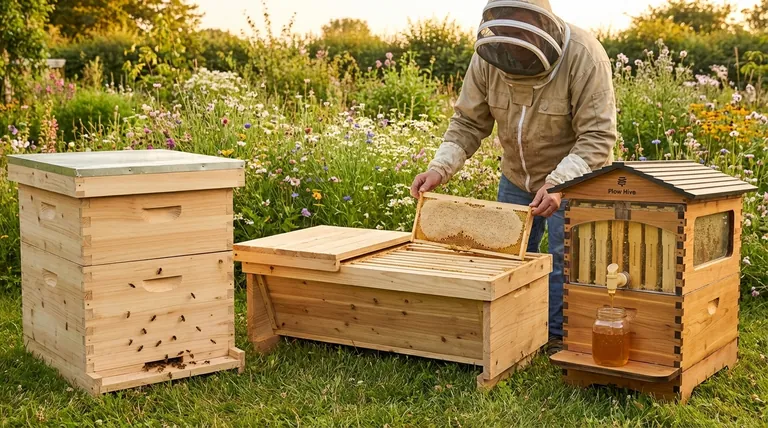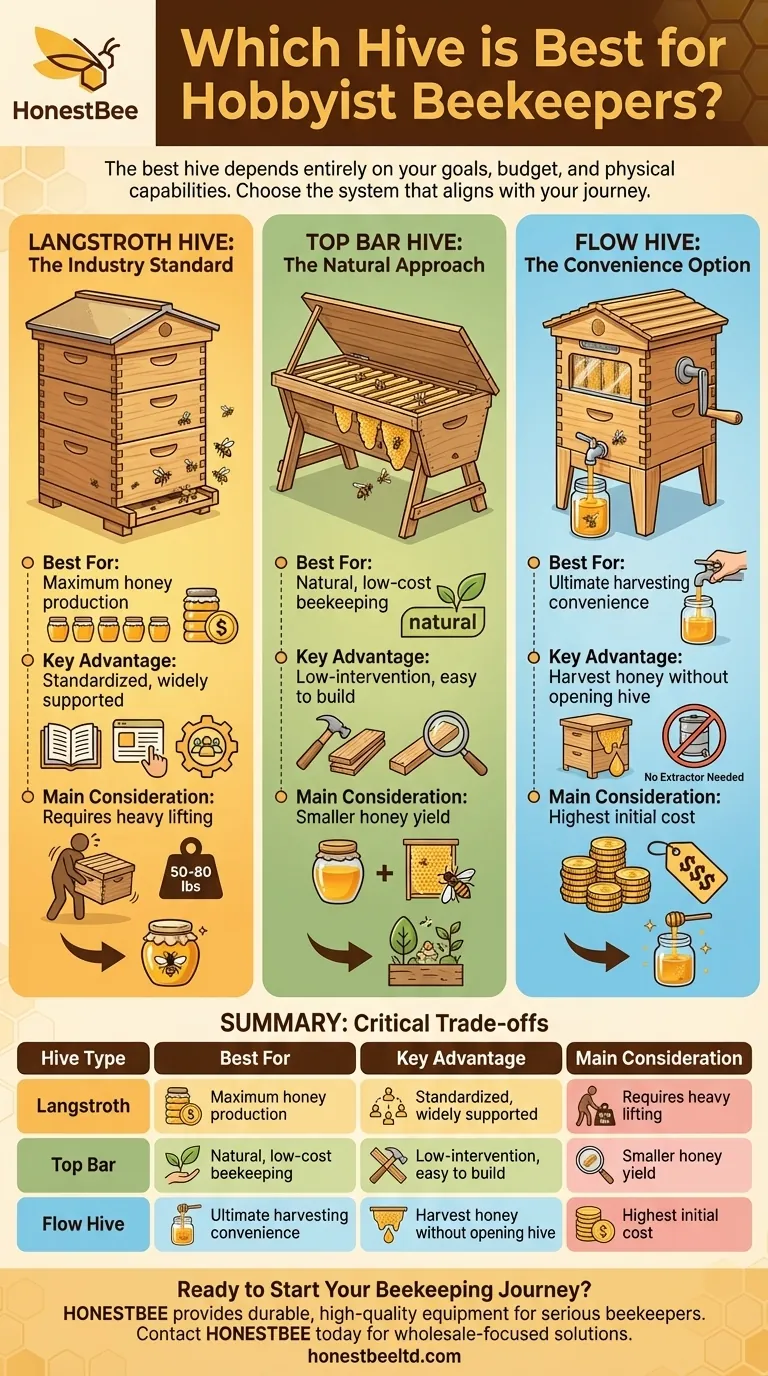The best hive for a hobbyist beekeeper depends entirely on your goals, budget, and physical capabilities. The three most common choices are the Langstroth for its standardization and high honey potential, the Top Bar hive for a more natural and low-cost approach, and the Flow Hive for its unparalleled convenience in honey harvesting. Each serves a different type of beekeeper.
Your choice of a beehive is the single most important decision you will make, as it fundamentally shapes your entire beekeeping experience. The "best" hive is not a specific product, but rather the system that best aligns with your primary goal, whether that is honey production, natural processes, or ease of use.

The Three Primary Hive Choices for Hobbyists
Understanding the core design and philosophy behind each major hive type is the first step toward making an informed decision. They are not interchangeable; each encourages a different style of management.
The Langstroth Hive: The Industry Standard
The Langstroth hive is the most recognizable and widely used hive in the world. It is a system of stackable, rectangular boxes (called "supers") that contain removable frames for the bees to build their comb on.
This hive is popular for a reason: it's affordable, readily available, and modular. Its greatest strength is the massive ecosystem of support, including books, online resources, and local beekeeping clubs familiar with its management. If your goal is maximizing honey production, the Langstroth is exceptionally effective when well-managed.
The Top Bar Hive: The Natural Approach
A Top Bar Hive (TBH) is a single, long trough-like box with simple wooden bars laid across the top. Bees build their comb down from these bars naturally, without the guidance of pre-made foundation sheets.
This design is ideal for beekeepers interested in natural beekeeping and who want to avoid heavy lifting, as you only ever lift one bar at a time. It's a low-cost option, especially if you build it yourself, and it requires no expensive honey extraction equipment. The trade-off is typically a smaller honey harvest compared to a Langstroth.
The Flow Hive: The Convenience Option
The Flow Hive is a modified Langstroth-style hive that features patented, pre-formed plastic frames. With the turn of a handle, these frames split the honeycomb cells vertically, allowing honey to drain out through a tap directly into a jar.
This system is designed for maximum convenience and minimal disturbance during the harvest. It completely eliminates the need for a honey extractor and significantly reduces the labor involved. It's an excellent choice for hobbyists who want to keep bees primarily for pollination and a small amount of easy-to-harvest honey, and who wish to avoid the heavy work associated with traditional hives.
Understanding the Critical Trade-offs
Choosing a hive involves balancing competing factors. What you gain in one area, you often sacrifice in another. Being aware of these trade-offs is key to avoiding frustration later.
Honey Yield vs. Heavy Lifting
The Langstroth hive is the champion of honey production, but this comes at a physical cost. A single box full of honey can weigh 50-80 pounds, and managing the hive requires lifting and restacking these heavy supers.
Conversely, both the Top Bar and Flow Hives are designed to avoid heavy lifting. In a Top Bar, you only lift individual combs. In a Flow Hive, the honey supers are often left in place all season. This ease of management, however, usually corresponds to a smaller total honey yield.
Initial Cost vs. Long-term Expense
Your initial investment varies dramatically between hive types. A Top Bar Hive is the cheapest, especially if you have basic woodworking skills and can build it from a plan. A Langstroth hive is moderately priced and widely available.
The Flow Hive represents the highest initial investment by a significant margin. While it saves you the future cost of a honey extractor (which can be several hundred dollars), its upfront price can be a barrier for many new hobbyists.
Community Support vs. Niche Systems
The biggest advantage of the Langstroth hive is standardization. Nearly every beekeeper you meet will understand it, and finding a mentor or buying compatible equipment is simple. This broad support network is invaluable for a beginner.
The Top Bar and Flow Hives have passionate but smaller communities. While support is available online, finding an experienced local mentor may be more challenging. This can make troubleshooting problems more difficult when you are just starting out.
How to Choose the Right Hive for You
There is no single "best" hive, only the hive that is best for your specific situation. Use your primary motivation as your guide.
- If your primary focus is maximum honey production and a proven, standardized system: The Langstroth hive is the clear choice for its efficiency and widespread support.
- If your primary focus is a natural, low-cost, and low-intervention experience: The Top Bar hive aligns perfectly with a philosophy centered on bee welfare and minimal equipment.
- If your primary focus is convenience, avoiding heavy work, and harvesting honey with ease: The Flow Hive is an excellent, albeit expensive, option that simplifies the most complex part of beekeeping.
By first defining your personal goals for keeping bees, you can confidently select the hive system that will bring you the most success and enjoyment.
Summary Table:
| Hive Type | Best For | Key Advantage | Main Consideration |
|---|---|---|---|
| Langstroth | Maximum honey production | Standardized, widely supported | Requires heavy lifting |
| Top Bar | Natural, low-cost beekeeping | Low-intervention, easy to build | Smaller honey yield |
| Flow Hive | Ultimate harvesting convenience | Harvest honey without opening hive | Highest initial cost |
Ready to Start Your Beekeeping Journey?
As a leading wholesale supplier to commercial apiaries and distributors, HONESTBEE provides the durable, high-quality equipment that serious beekeepers rely on. Whether you're drawn to the efficiency of a Langstroth, the natural approach of a Top Bar, or the innovation of a Flow Hive, we have the foundational supplies to support your success.
Contact HONESTBEE today to discuss your beekeeping equipment needs and learn how our wholesale-focused operations can benefit your hobby or small-scale apiary.
Visual Guide

Related Products
- Langstroth Bee Hives Bee Keeping Box for Beginners Beekeeping
- Long Langstroth Style Horizontal Top Bar Hive for Wholesale
- HONESTBEE Professional Multi-Functional Hive Tool with Ergonomic Wood Handle
- Multi-Function Plier-Style Frame Grip Hive Tool
- HONESTBEE Advanced Ergonomic Stainless Steel Hive Tool for Beekeeping
People Also Ask
- Why were wooden hives traditionally preferred? For Natural Beekeeping Aligned with Bee Biology
- Should a beginner try a different type of hive? Start with a Langstroth for a solid foundation.
- How does the ease of access differ between 8-frame and 10-frame hives? Choose the Right Hive for Your Body
- Why are Langstroth hives recommended for beginners? Unmatched Support & Standardization
- Why might a beginner be advised to start with a Langstroth hive? Unlock a Supportive Beekeeping Ecosystem



















